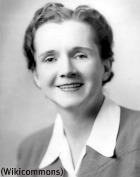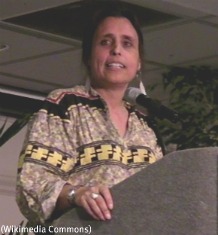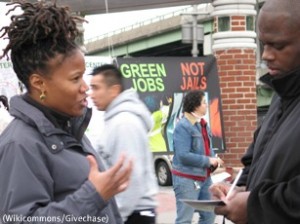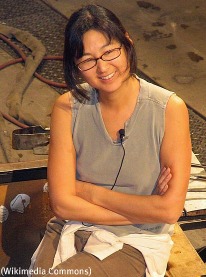We have much more to do and your continued support is needed now more than ever.
Women Conservationists, Always Ahead of the Curve
I’ll admit it: when I think of American conservationists, old guys like Teddy Roosevelt and John Muir spring to mind. I’m sure I’m not the only one to sometimes overlook the enormous role women have played, and continue to play, in the protection of wildlife and the environment. March is International Women’s Month and the perfect time to take a look at the important contributions women have made to the field of conservation. The following women each pioneered innovative ways to address the environmental challenges facing their generations and stepped up to meet the needs of their individual communities.
 Rachel Carson
Rachel Carson
I wouldn’t feel right about starting with anyone other than Rachel Carson. This extraordinary woman and author brought environmental awareness to mainstream America in 1962 with her book Silent Spring, which exposed the hazards of pesticide use. The book introduced the idea that science and industry could pose a serious threat to the environment and public health. Her work also pointed out the need for environmental regulation — the EPA calls itself the extended shadow of Rachel Carson.
“Those who contemplate the beauty of the earth find reserves of strength that will endure as long as life lasts.”
Margaret “Mardy” Murie
Considered the “grandmother of conservation,” Margaret “Mardy” Murie grew up in Fairbanks, Alaska, where her love of wilderness began. She married naturalist and biologist Olaus Murie in 1924, and their outdoor adventures led her to a life dedicated to the preservation of wild places. Her tireless advocacy led to the the protection of some of the most important wilderness areas left on the planet, including Alaska’s Arctic National Wildlife Refuge. Her testimony was instrumental in the passage of the 1980 Alaska National Interest Lands Conservation Act, legislation that set aside 104 million acres of land in Alaska and doubled the size of the Arctic National Wildlife Refuge. In 2003, at age 100, Murie received the National Wildlife Federation’s highest honor, J.N. “Ding” Darling Conservationist of the Year.
“I am testifying as an emotional woman and I would like to ask you, gentlemen, what’s wrong with emotion? Beauty is a resource in and of itself. Alaska must be allowed to be Alaska, that is her greatest economy. I hope the United States of America is not so rich that she can afford to let these wildernesses pass by, or so poor she cannot afford to keep them.”
Winona LaDuke
An Anishinaabekwe enrolled member of the Mississippi Band Anishinaabeg, Winona LaDuke is a Native American environmentalist, activist, writer, and orator who advocates on issues of climate change, renewable energy, sustainable development, food systems, and environmental justice. She co-founded the Native American-led organization, Honor the Earth, that works to raise public awareness and increase financial resources for the Native environmental movement. She lives on the White Earth Ojibwe Reservation in Minnesota where she works to help land-based communities protect their cultures and traditions. LaDuke also joined Ralph Nadar on the Green Party ticket in 1996 and 2000. Watch her present comedian Stephen Colbert with an Ojibwe nickname in this clip from The Colbert Report in 2008.
“Power is not brute force and money; power is in your spirit. Power is in your soul. It is what your ancestors, your old people gave you. Power is in the earth; it is in your relationship to the earth.”
Majora Carter
In an incredibly compelling, emotionally-charged TED talk, Majora Carter defines environmental justice with the statement: “No community should be saddled with more environmental burdens and less environmental benefits than any other.” This amazing activist works to transform under-served communities into sustainable places to live, something she calls “greening the ghetto.” She started with her own neighborhood by founding the non-profit Sustainable South Bronx and continues to help communities throughout the country solve challenges with environmentally sustainable solutions.
“We need to work together to embrace and repair our land, repair our power systems and repair ourselves.”
Maya Lin
She may be best known for designing the Vietnam Veterans Memorial in Washington, DC, but Maya Lin is also a conservationist whose art aims to bring awareness to pressing environmental issues. She has collaborated with Pacific Northwest tribes, civic groups, and other artists on the Confluence Project, a series of seven installations along the Columbia River Basin that explore the intersection of environment, cultures, and regional history. Her memorial entitled “What is Missing” features a webpage and multiple installations that focus on biodiversity and habitat loss. Visit her MAYA LIN STUDIO to find out more about her art, architecture, and memorials.
“I think the natural environment is beautiful; nothing I can do is going to be better than what nature has done. So when I approach a site, I want to do it with a lot of respect, with a gentle touch, and whatever buildings I put down, I want them to frame and give you views out to the landscape — to have you be a part of and connected to the landscape. I really believe you can teach people that way. They may not be aware of what is going on with the architecture, but you can make them feel a part of nature — not above it, not superior to it, and not conquering it.”

























